A Hybrid Fuzzy Inference System Based on Dispersion Model for Quantitative Environmental Health Impact Assessment of Urban Transportation Planning
Abstract
:1. Introduction
2. Transportation and Air Pollution in the City of Isfahan
- Current condition is considered as the baseline scenario. Dispersion model and hierarchical fuzzy inference system are developed and tested based on this scenario. The classification of current transport fleet according to the emission standard is tabulated in Table 1.
- Odd/Even scenario is one of the most important plans proposed to cope with air pollution in Isfahan. This plan, however, is not successful in practice. Lack of supervision in Odd/Even zone, lack of police and citizen acceptability and cooperation, and the nature of the plan are the main reasons of failure [52]. Modeling by Transport and Traffic Department of Isfahan Municipality has determined what the traverse of transport fleet would be if the plan fully implemented (Figure 1).
- Low emission zone [53] plan is widely applied in many countries to reduce air pollution. The studies run on the main parameters affecting air pollution in Isfahan, have presented three preliminary proposals with the objective of establishing LEZ: (1) restriction for old diesel vehicles; (2) restriction on motorcycle traffic in downtown; and (3) traffic ban for passenger cars and vans with respect to their emission levels in different zones (Figure 2). Modeling by the Transport and Traffic Department of Isfahan Municipality has determined the changes of traffic if LEZ scenario will be fully implemented.
3. An Approach for Environmental Health Impact Assessment of Urban Transportation Planning
3.1. Hybrid Hierarchical Fuzzy Inference System (HIFS)
3.2. Hierarchical Fuzzy Inference Model for Modeling Traffic Related PM2.5
3.3. Hierarchical Fuzzy Inference System for Modeling Health Impacts
3.3.1. Health Impact Metrics for Air Pollution Scenario Assessment
3.3.2. Converting Health Impact Metric to the Hierarchical Fuzzy Inference System
4. Practical Evaluation
4.1. Data Preparation and Experimental Setup
4.2. Results and Discussion
4.2.1. Implementation and Evaluation of Hierarchical Fuzzy Inference Systems
4.2.2. Scenarios Evaluations
5. Conclusions
Acknowledgments
Author Contributions
Conflicts of Interest
References
- Hebert, K.A.; Wendel, A.M.; Kennedy, S.K.; Dannenberg, A.L. Health impact assessment: A comparison of 45 local, national, and international guidelines. Environ. Impact Assess. Rev. 2012, 34, 74–82. [Google Scholar] [CrossRef]
- Mesa-Frias, M.; Chalabi, Z.; Vanni, T.; Foss, A.M. Uncertainty in environmental health impact assessment: Quantitative methods and perspectives. Int. J. Environ. Health Res. 2013, 23, 16–30. [Google Scholar] [CrossRef] [PubMed]
- Dannenberg, A.L.; Bhatia, R.; Cole, B.L.; Heaton, S.K.; Feldman, J.D.; Rutt, C.D. Use of health impact assessment in the US: 27 case studies, 1999–2007. Am. J. Prev. Med. 2008, 34, 241–256. [Google Scholar] [CrossRef] [PubMed]
- Singleton-Baldrey, L. The Impacts of Health Impact Assessment: A Review of 54 Health Impact Assessments, 2007–2012; University of North Carolina: Chapel Hill, NC, USA, 2012. [Google Scholar]
- Rhodus, J.; Fulk, F.; Autrey, B.; O’Shea, S.; Roth, A. A Review of Health Impact Assessments in the US: Current State-of-Science, Best Practices, and Areas for Improvement; Environmental Protection Agency: Cincinnati, OH, USA, 2013.
- White, L.; Noble, B.F. Strategic environmental assessment for sustainability: A review of a decade of academic research. Environ. Impact Assess. Rev. 2013, 42, 60–66. [Google Scholar] [CrossRef]
- Kentel, E.; Aral, M. 2D monte carlo versus 2D fuzzy monte carlo health risk assessment. Stoch. Environ. Res. Risk Assess. 2005, 19, 86–96. [Google Scholar] [CrossRef]
- Arunraj, N.; Mandal, S.; Maiti, J. Modeling uncertainty in risk assessment: An integrated approach with fuzzy set theory and monte carlo simulation. Accid. Anal. Prev. 2013, 55, 242–255. [Google Scholar] [CrossRef] [PubMed]
- Chart-asa, C.; Gibson, J.M. Health impact assessment of traffic-related air pollution at the urban project scale: Influence of variability and uncertainty. Sci. Total Environ. 2015, 506, 409–421. [Google Scholar] [CrossRef] [PubMed]
- De Hoogh, K.; Korek, M.; Vienneau, D.; Keuken, M.; Kukkonen, J.; Nieuwenhuijsen, M.J.; Badaloni, C.; Beelen, R.; Bolignano, A.; Cesaroni, G. Comparing land use regression and dispersion modelling to assess residential exposure to ambient air pollution for epidemiological studies. Environ. Int. 2014, 73, 382–392. [Google Scholar] [CrossRef] [PubMed]
- Dockery, D.W.; Pope, C.A.; Xu, X.; Spengler, J.D.; Ware, J.H.; Fay, M.E.; Ferris, B.G., Jr.; Speizer, F.E. An association between air pollution and mortality in six us cities. N. Engl. J. Med. 1993, 329, 1753–1759. [Google Scholar] [CrossRef] [PubMed]
- Jerrett, M.; Arain, A.; Kanaroglou, P.; Beckerman, B.; Potoglou, D.; Sahsuvaroglu, T.; Morrison, J.; Giovis, C. A review and evaluation of intraurban air pollution exposure models. J. Expo. Sci. Environ. Epidemiol. 2005, 15, 185–204. [Google Scholar] [CrossRef] [PubMed]
- Miller, K.A.; Siscovick, D.S.; Sheppard, L.; Shepherd, K.; Sullivan, J.H.; Anderson, G.L.; Kaufman, J.D. Long-term exposure to air pollution and incidence of cardiovascular events in women. N. Engl. J. Med. 2007, 356, 447–458. [Google Scholar] [CrossRef] [PubMed]
- Kheirbek, I.; Wheeler, K.; Walters, S.; Kass, D.; Matte, T. PM2.5 and ozone health impacts and disparities in New York city: Sensitivity to spatial and temporal resolution. Air Qual. Atmos. Health 2013, 6, 473–486. [Google Scholar] [CrossRef] [PubMed]
- Batterman, S.; Chambliss, S.; Isakov, V. Spatial resolution requirements for traffic-related air pollutant exposure evaluations. Atmos. Environ. 2014, 94, 518–528. [Google Scholar] [CrossRef] [PubMed]
- Hoek, G.; Beelen, R.; de Hoogh, K.; Vienneau, D.; Gulliver, J.; Fischer, P.; Briggs, D. A review of land-use regression models to assess spatial variation of outdoor air pollution. Atmos. Environ. 2008, 42, 7561–7578. [Google Scholar] [CrossRef]
- Clougherty, J.E.; Kheirbek, I.; Eisl, H.M.; Ross, Z.; Pezeshki, G.; Gorczynski, J.E.; Johnson, S.; Markowitz, S.; Kass, D.; Matte, T. Intra-urban spatial variability in wintertime street-level concentrations of multiple combustion-related air pollutants: The New York city community air survey (NYCCAS). J. Expo. Sci. Environ. Epidemiol. 2013, 23, 232–240. [Google Scholar] [CrossRef] [PubMed]
- Basagaña, X.; Aguilera, I.; Rivera, M.; Agis, D.; Foraster, M.; Marrugat, J.; Elosua, R.; Künzli, N. Measurement error in epidemiologic studies of air pollution based on land-use regression models. Am. J. Epidemiol. 2013, 178, 1342–1346. [Google Scholar] [CrossRef] [PubMed]
- Alexeeff, S.E.; Schwartz, J.; Kloog, I.; Chudnovsky, A.; Koutrakis, P.; Coull, B.A. Consequences of kriging and land use regression for PM2.5 predictions in epidemiologic analyses: Insights into spatial variability using high-resolution satellite data. J. Expo. Sci. Environ. Epidemiol. 2015, 25, 138–144. [Google Scholar] [CrossRef] [PubMed]
- Su, J.G.; Brauer, M.; Ainslie, B.; Steyn, D.; Larson, T.; Buzzelli, M. An innovative land use regression model incorporating meteorology for exposure analysis. Sci. Total Environ. 2008, 390, 520–529. [Google Scholar] [CrossRef] [PubMed]
- Wilton, D.C. Modelling Nitrogen Oxides in Los Angeles Using a Hybrid Dispersion/Land Use Regression Model; University of Washington: Seattle, WA, USA, 2011. [Google Scholar]
- HEI. Traffic-Related Air Pollution: A Critical Review of the Literature on Emissions, Exposure, and Health Effectsspecial Reports; HEI: Honolulu, HI, USA, 2010. [Google Scholar]
- Brauer, M.; Ainslie, B.; Buzzelli, M.; Henderson, S.; Larson, T.; Marshall, J.; Nethery, E.; Steyn, D.; Su, J. Models of exposure for use in epidemiological studies of air pollution health impacts. In Air Pollution Modeling and Its Application XIX; Springer: Berlin, Germany, 2008; pp. 589–604. [Google Scholar]
- Michanowicz, A. Hybrid Dispersion/Land Use Regression Modeling for Improving Air Pollutant Concentration Estimates; University of Pittsburgh: Pittsburgh, PA, USA, 2015. [Google Scholar]
- Marshall, J.D.; Nethery, E.; Brauer, M. Within-urban variability in ambient air pollution: Comparison of estimation methods. Atmos. Environ. 2008, 42, 1359–1369. [Google Scholar] [CrossRef]
- Wilton, D.; Szpiro, A.; Gould, T.; Larson, T. Improving spatial concentration estimates for nitrogen oxides using a hybrid meteorological dispersion/land use regression model in Los Angeles, CA and Seattle, WA. Sci. Total Environ. 2010, 408, 1120–1130. [Google Scholar] [CrossRef] [PubMed]
- Lindström, J.; Szpiro, A.A.; Sampson, P.D.; Oron, A.P.; Richards, M.; Larson, T.V.; Sheppard, L. A flexible spatio-temporal model for air pollution with spatial and spatio-temporal covariates. Environ. Ecol. Stat. 2014, 21, 411–433. [Google Scholar] [CrossRef] [PubMed]
- Isakov, V.; Touma, J.S.; Burke, J.; Lobdell, D.T.; Palma, T.; Rosenbaum, A.; kÖzkaynak, H. Combining regional-and local-scale air quality models with exposure models for use in environmental health studies. J. Air Waste Manag. Assoc. 2009, 59, 461–472. [Google Scholar] [PubMed]
- Johnson, M.; Isakov, V.; Touma, J.; Mukerjee, S.; Özkaynak, H. Evaluation of land-use regression models used to predict air quality concentrations in an urban area. Atmos. Environ. 2010, 44, 3660–3668. [Google Scholar] [CrossRef]
- Mölter, A.; Lindley, S.; de Vocht, F.; Simpson, A.; Agius, R. Modelling air pollution for epidemiologic research—Part i: A novel approach combining land use regression and air dispersion. Sci. Total Environ. 2010, 408, 5862–5869. [Google Scholar] [CrossRef] [PubMed]
- Martenies, S.E.; Wilkins, D.; Batterman, S.A. Health impact metrics for air pollution management strategies. Environ. Int. 2015, 85, 84–95. [Google Scholar] [CrossRef] [PubMed]
- Walker, W.E.; Harremoës, P.; Rotmans, J.; van der Sluijs, J.P.; van Asselt, M.B.; Janssen, P.; von Krauss, M.P.K. Defining uncertainty: A conceptual basis for uncertainty management in model-based decision support. Integr. Assess. 2003, 4, 5–17. [Google Scholar] [CrossRef]
- Briggs, D.J.; Sabel, C.E.; Lee, K. Uncertainty in epidemiology and health risk and impact assessment. Environ. Geochem. Health 2008, 31, 189–203. [Google Scholar] [CrossRef] [PubMed]
- Ryan, L. Epidemiologically based environmental risk assessment. Stat. Sci. 2003, 18, 466–480. [Google Scholar] [CrossRef]
- Leung, W.; Noble, B.; Gunn, J.; Jaeger, J.A. A review of uncertainty research in impact assessment. Environ. Impact Assess. Rev. 2015, 50, 116–123. [Google Scholar] [CrossRef]
- Ryan, L. Combining data from multiple sources, with applications to environmental risk assessment. Stat. Med. 2008, 27, 698–710. [Google Scholar] [CrossRef] [PubMed]
- Hobbs, B.F.; Stakhiv, E.Z.; Grayman, W.M. Impact evaluation procedures: Theory, practice, and needs. J. Water Resour. Plan. Manag. 1989, 115, 2–21. [Google Scholar] [CrossRef]
- Veerman, J.; Barendregt, J.; Mackenbach, J. Quantitative health impact assessment: Current practice and future directions. J. Epidemiol. Community Health 2005, 59, 361–370. [Google Scholar] [CrossRef] [PubMed]
- Stoeglehner, G. Enhancing sea effectiveness: Lessons learnt from austrian experiences in spatial planning. Impact Assess. Proj. Apprais. 2010, 28, 217–231. [Google Scholar] [CrossRef]
- Hosseiniebalam, F.; Ghaffarpasand, O. The effects of emission sources and meteorological factors on sulphur dioxide concentration of great isfahan, Iran. Atmos. Environ. 2015, 100, 94–101. [Google Scholar] [CrossRef]
- Karimi, H.; Soffianian, A.; Mirghaffari, N.; Soltani, S. Determining air pollution potential using geographic information systems and multi-criteria evaluation: A case study in isfahan province in Iran. Environ. Process. 2016, 3, 229–246. [Google Scholar] [CrossRef]
- Zarrabi, A.; Mohammadi, J.; Abdollahi, A. Evaluation of mobile and stationary sources of Isfahan air pollution (in persian). Geography 2010, 26, 151–164. [Google Scholar]
- Han, X.; Naeher, L.P. A review of traffic-related air pollution exposure assessment studies in the developing world. Environ. Int. 2006, 32, 106–120. [Google Scholar] [CrossRef] [PubMed]
- Karagulian, F.; Belis, C.A.; Dora, C.F.C.; Prüss-Ustün, A.M.; Bonjour, S.; Adair-Rohani, H.; Amann, M. Contributions to cities’ ambient particulate matter (PM): A systematic review of local source contributions at global level. Atmos. Environ. 2015, 120, 475–483. [Google Scholar] [CrossRef]
- Arfaeinia, H.; Kermani, M.; Aghaei, M.; Bahrami Asl, F.; Karimzadeh, S. Comparative investigation of health quality of air in Tehran, Isfahan and Shiraz metropolises in 2011–2012. J. Health Field 2014, 1, 37–44. [Google Scholar]
- Mansouri, B.; Hamidian, A.H. Assessment of the air quality of isfahan city, Iran, using selected air quality parameters. J. Int. Environ. Appl. Sci. 2013, 8, 10. [Google Scholar]
- DOE. Isfahan Department of Environment. Available online: http://isfahan-doe.ir/ (accessed on 28 December 2016).
- Rusu-Zagar, G.; Rusu-Zagar, C.; Iorga, I.; Iorga, A. Air pollution particles PM10, PM2.5 and the tropospheric ozone effects on human health. Procedia-Soc. Behav. Sci. 2013, 92, 826–831. [Google Scholar] [CrossRef]
- Ezzati, M.; Lopez, A.D.; Rodgers, A.; Vander Hoorn, S.; Murray, C.J. Selected major risk factors and global and regional burden of disease. Lancet 2002, 360, 1347–1360. [Google Scholar] [CrossRef]
- WHO (World Health Organization). The World Health Report 2002: Reducing Risks, Promoting Healthy Life; World Health Organization: Geneva, Switzerland, 2002. [Google Scholar]
- Bart, O. Outdoor air pollution: Assessing the environmental burden of disease at national and local levels. In Environmental Burden of Disease Series; OMS: Geneva, Switzerland, 2004; Volume 5. [Google Scholar]
- Latifi Sara, R.M.; Solmaz, A.; Vahid, H. The Plan of First Low Emission Zone for Tehran, Iran. Available online: http://air.tehran.ir/portals/0/ReportFiles/AirPollution/New/13.pdf (accessed on 16 January 2017). (In Persian)
- Del Campo, A.G. Incorporating spatial data and gis to improve sea of land use plans: Opportunities and limitations: Case studies in the republic of Ireland. Doctoral 2008. [Google Scholar] [CrossRef]
- Ocampo-Duque, W.; Osorio, C.; Piamba, C.; Schuhmacher, M.; Domingo, J.L. Water quality analysis in rivers with non-parametric probability distributions and fuzzy inference systems: Application to the Cauca River, Colombia. Environ. Int. 2013, 52, 17–28. [Google Scholar] [CrossRef] [PubMed]
- Zajaczkowski, J.; Verma, B. Selection and impact of different topologies in multi-layered hierarchical fuzzy systems. Appl. Intell. 2012, 36, 564–584. [Google Scholar] [CrossRef]
- Tashayo, B.; Alimohammadi, A. Modeling urban air pollution with optimized hierarchical fuzzy inference system. Environ. Sci. Pollut. Res. 2016, 23, 19417–19431. [Google Scholar] [CrossRef] [PubMed]
- Alcalá, R.; Alcalá-Fdez, J.; Herrera, F. A proposal for the genetic lateral tuning of linguistic fuzzy systems and its interaction with rule selection. IEEE Trans. Fuzzy Syst. 2007, 15, 616–635. [Google Scholar] [CrossRef]
- Herrera, F.; Lozano, M.; Verdegay, J.L. Tackling real-coded genetic algorithms: Operators and tools for behavioural analysis. Artif. Intell. Rev. 1998, 12, 265–319. [Google Scholar] [CrossRef]
- Isakov, V.; Arunachalam, S.; Batterman, S.; Bereznicki, S.; Burke, J.; Dionisio, K.; Garcia, V.; Heist, D.; Perry, S.; Snyder, M. Air quality modeling in support of the near-road exposures and effects of urban air pollutants study (nexus). Int. J. Environ. Res. Public Health 2014, 11, 8777–8793. [Google Scholar] [CrossRef] [PubMed]
- Aggarwal, P.; Jain, S. Impact of air pollutants from surface transport sources on human health: A modeling and epidemiological approach. Environ. Int. 2015, 83, 146–157. [Google Scholar] [CrossRef] [PubMed]
- Aliyu, A.S.; Ramli, A.T.; Saleh, M.A. Assessment of potential human health and environmental impacts of a nuclear power plant (npp) based on atmospheric dispersion modeling. Atmósfera 2015, 28, 13–26. [Google Scholar] [CrossRef]
- Batterman, S.; Ganguly, R.; Harbin, P. High resolution spatial and temporal mapping of traffic-related air pollutants. Int. J. Environ. Res. Public Health 2015, 12, 3646–3666. [Google Scholar] [CrossRef] [PubMed]
- Penn, S.L.; Arunachalam, S.; Tripodis, Y.; Heiger-Bernays, W.; Levy, J.I. A comparison between monitoring and dispersion modeling approaches to assess the impact of aviation on concentrations of black carbon and nitrogen oxides at Los Angeles international airport. Sci. Total Environ. 2015, 527, 47–55. [Google Scholar] [CrossRef] [PubMed]
- Rowangould, G.M. A new approach for evaluating regional exposure to particulate matter emissions from motor vehicles. Transp. Res. Part D Transp. Environ. 2015, 34, 307–317. [Google Scholar] [CrossRef]
- Michanowicz, D.R.; Shmool, J.L.; Tunno, B.J.; Tripathy, S.; Gillooly, S.; Kinnee, E.; Clougherty, J.E. A hybrid land use regression/aermod model for predicting intra-urban variation in PM2.5. Atmos. Environ. 2016, 131, 307–315. [Google Scholar] [CrossRef]
- Ostro, B.; Chestnut, L. Assessing the health benefits of reducing particulate matter air pollution in the United States. Environ. Res. 1998, 76, 94–106. [Google Scholar] [CrossRef] [PubMed]
- Li, Y.; Gibson, J.M.; Jat, P.; Puggioni, G.; Hasan, M.; West, J.J.; Vizuete, W.; Sexton, K.; Serre, M. Burden of disease attributed to anthropogenic air pollution in the United Arab Emirates: Estimates based on observed air quality data. Sci. Total Environ. 2010, 408, 5784–5793. [Google Scholar] [CrossRef] [PubMed]
- Mesa-Frias, M.; Chalabi, Z.; Foss, A.M. Quantifying uncertainty in health impact assessment: A case-study example on indoor housing ventilation. Environ. Int. 2014, 62, 95–103. [Google Scholar] [CrossRef] [PubMed]
- United States Environmental Protection Agency. Transportation Conformity Guidance for Quantitative Hot-Spot Analyses in PM2.5 and PM10 Nonattainment and Maintenance Areas (No. Epa-420-b-10–040); United States Environmental Protection Agency: Research Triangle Park, NC, USA, 2010.
- JICA (Japan International Cooperation Agency). The Study on an Integrated Master Plan for Air Pollution Control in the Greater Tehran Area in the Islamic Republic of Iran; Japan International Cooperation Agency: Tokyo, Japan, 1997.
- Shahbazi, H.; Babaei, M.; Afshin, H.; Hosseini, V. Emission Inventory of Tehran for 1392—Mobile Sources. Available online: http://air.tehran.ir/portals/0/ReportFiles/AirPollution/New/27.pdf (accessed on 16 January 2017). (In Persian)
- McNally, M.G. The four step model. Handb. Transp. Model. 2007, 1, 35–41. [Google Scholar]
- Zhou, Y.; Levy, J.I. Factors influencing the spatial extent of mobile source air pollution impacts: A meta-analysis. BMC Public Health 2007, 7, 89. [Google Scholar] [CrossRef] [PubMed]
- Karner, A.A.; Eisinger, D.S.; Niemeier, D.A. Near-roadway air quality: Synthesizing the findings from real-world data. Environ. Sci. Technol. 2010, 44, 5334–5344. [Google Scholar] [CrossRef] [PubMed]
- Yazdi, M.N.; Delavarrafiee, M.; Arhami, M. Evaluating near highway air pollutant levels and estimating emission factors: Case study of Tehran, Iran. Sci. Total Environ. 2015, 538, 375–384. [Google Scholar] [CrossRef] [PubMed]
- Tenailleau, Q.M.; Mauny, F.; Joly, D.; François, S.; Bernard, N. Air pollution in moderately polluted urban areas: How does the definition of “neighborhood” impact exposure assessment? Environ. Pollut. 2015, 206, 437–448. [Google Scholar] [CrossRef] [PubMed]
- Hoek, G.; Krishnan, R.M.; Beelen, R.; Peters, A.; Ostro, B.; Brunekreef, B.; Kaufman, J.D. Long-term air pollution exposure and cardio-respiratory mortality: A review. Environ. Health 2013, 12, 1. [Google Scholar] [CrossRef] [PubMed]
- DOE (Isfahan Department of Environment). Comprehensive Fugitive Dust and Particulate Matter Control Plan in the Central Isfahan Province; Isfahan Department of Environment: Isfahan, Iran, 2015.
- Paatero, P.; Tapper, U. Positive matrix factorization: A non-negative factor model with optimal utilization of error estimates of data values. Environmetrics 1994, 5, 111–126. [Google Scholar] [CrossRef]
- Viana, M.; Kuhlbusch, T.; Querol, X.; Alastuey, A.; Harrison, R.; Hopke, P.; Winiwarter, W.; Vallius, M.; Szidat, S.; Prevot, A. Source apportionment of particulate matter in Europe: A review of methods and results. J. Aerosol Sci. 2008, 39, 827–849. [Google Scholar] [CrossRef]
- Norris, G.; Duvall, R.; Brown, S.; Bai, S. Epa Positive Matrix Factorization (PMF) 5.0 Fundamentals and User Guide; US Environmental Protection Agency Office of Research and Development: Washington, DC, USA, 2014.
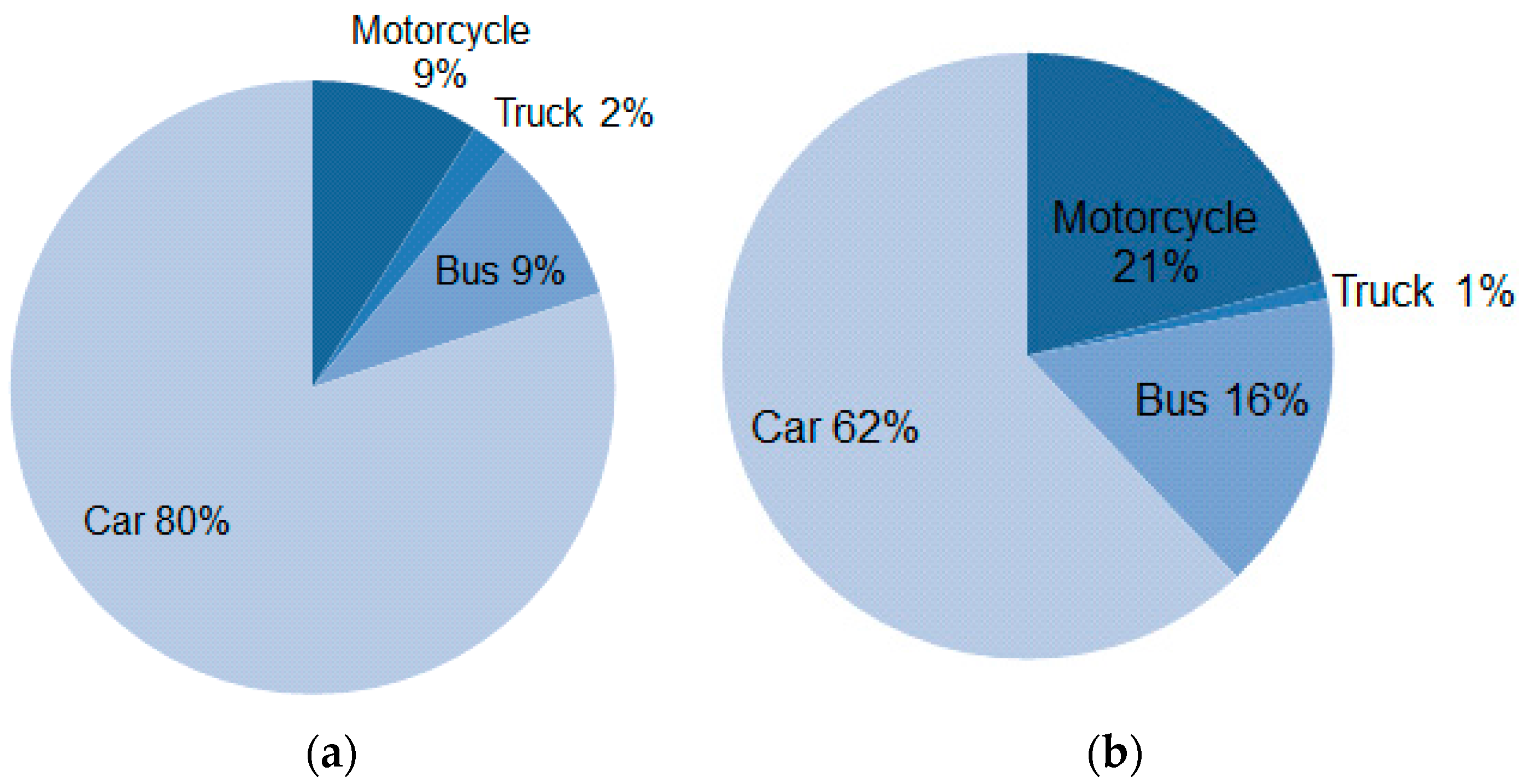

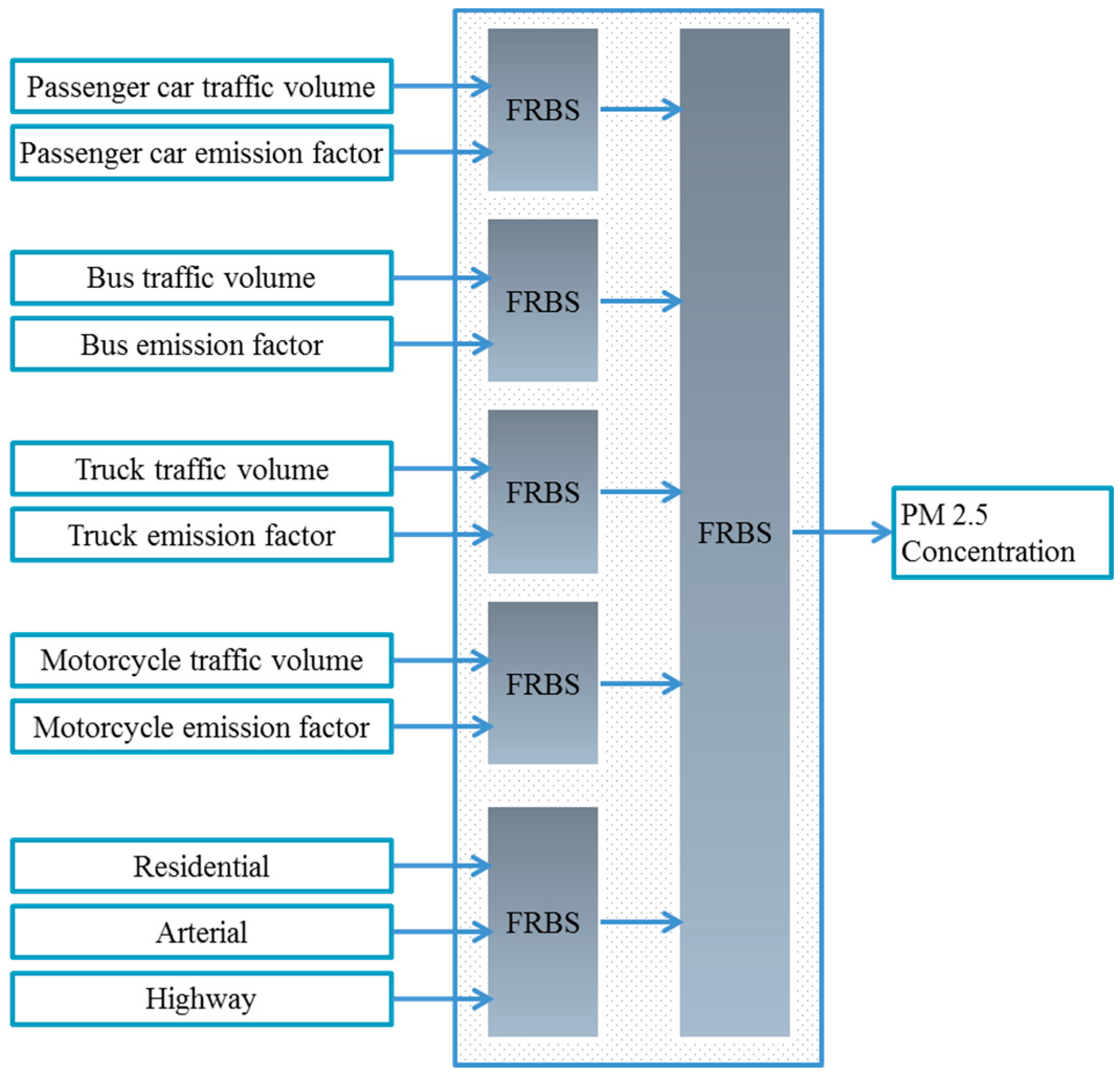
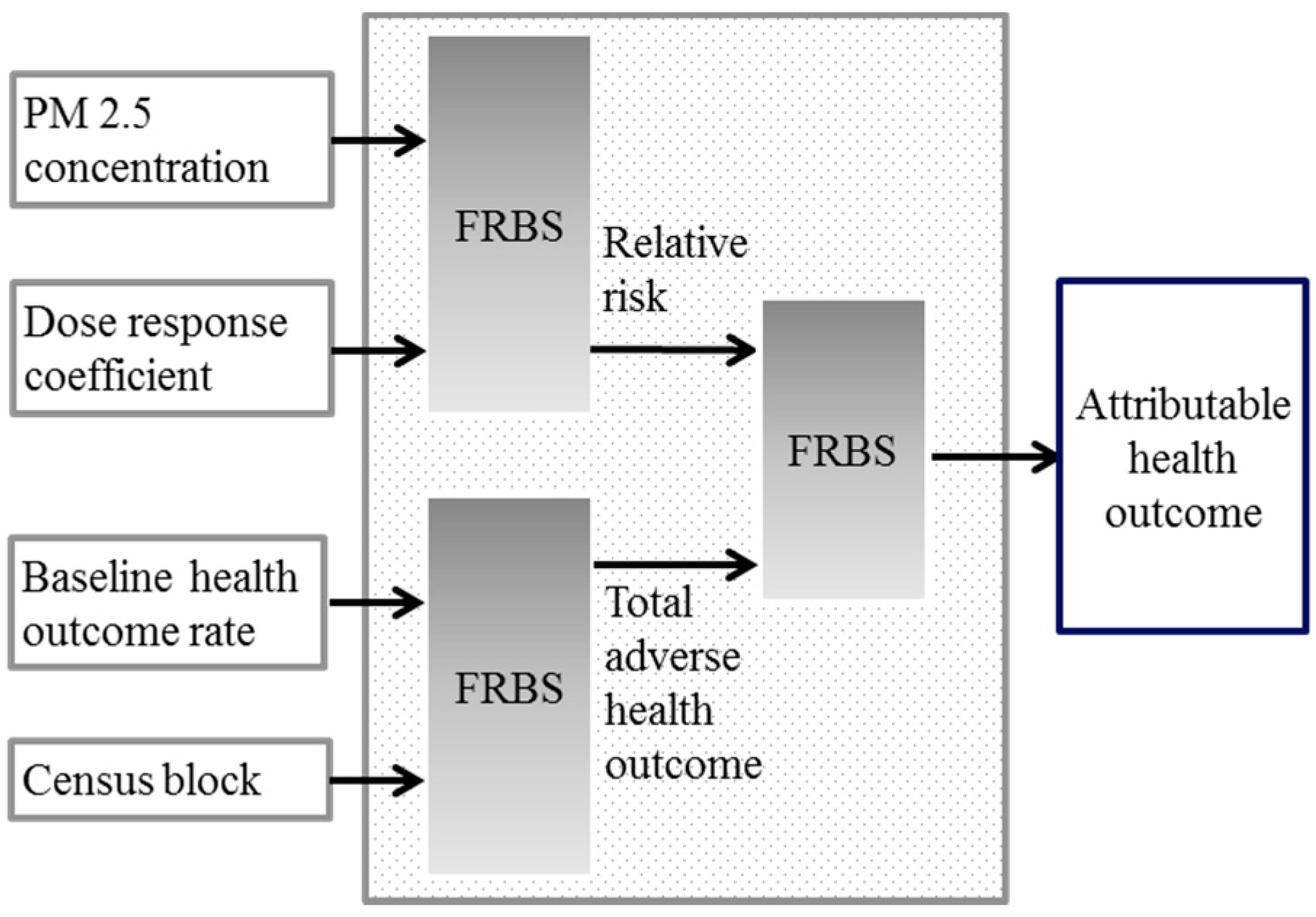
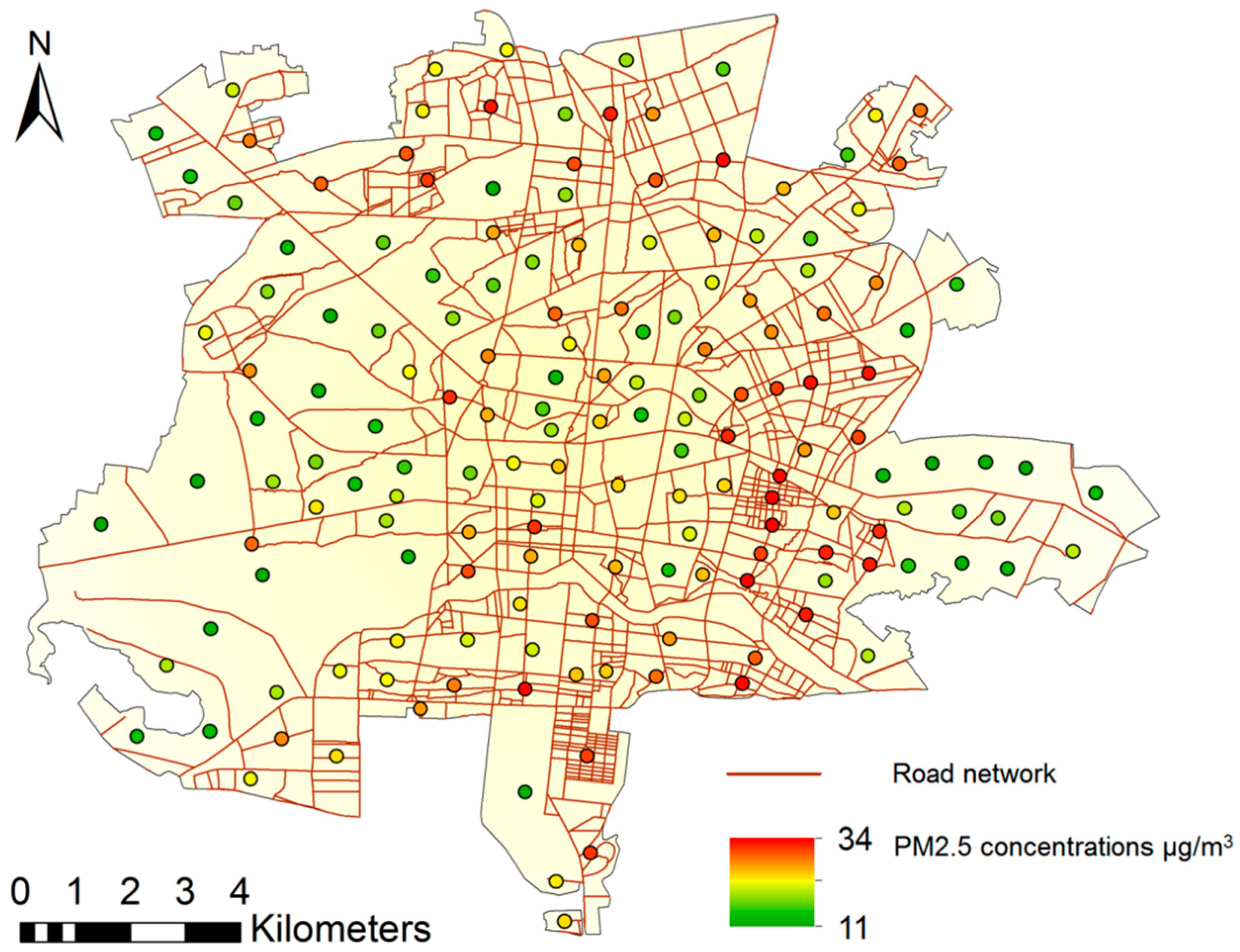

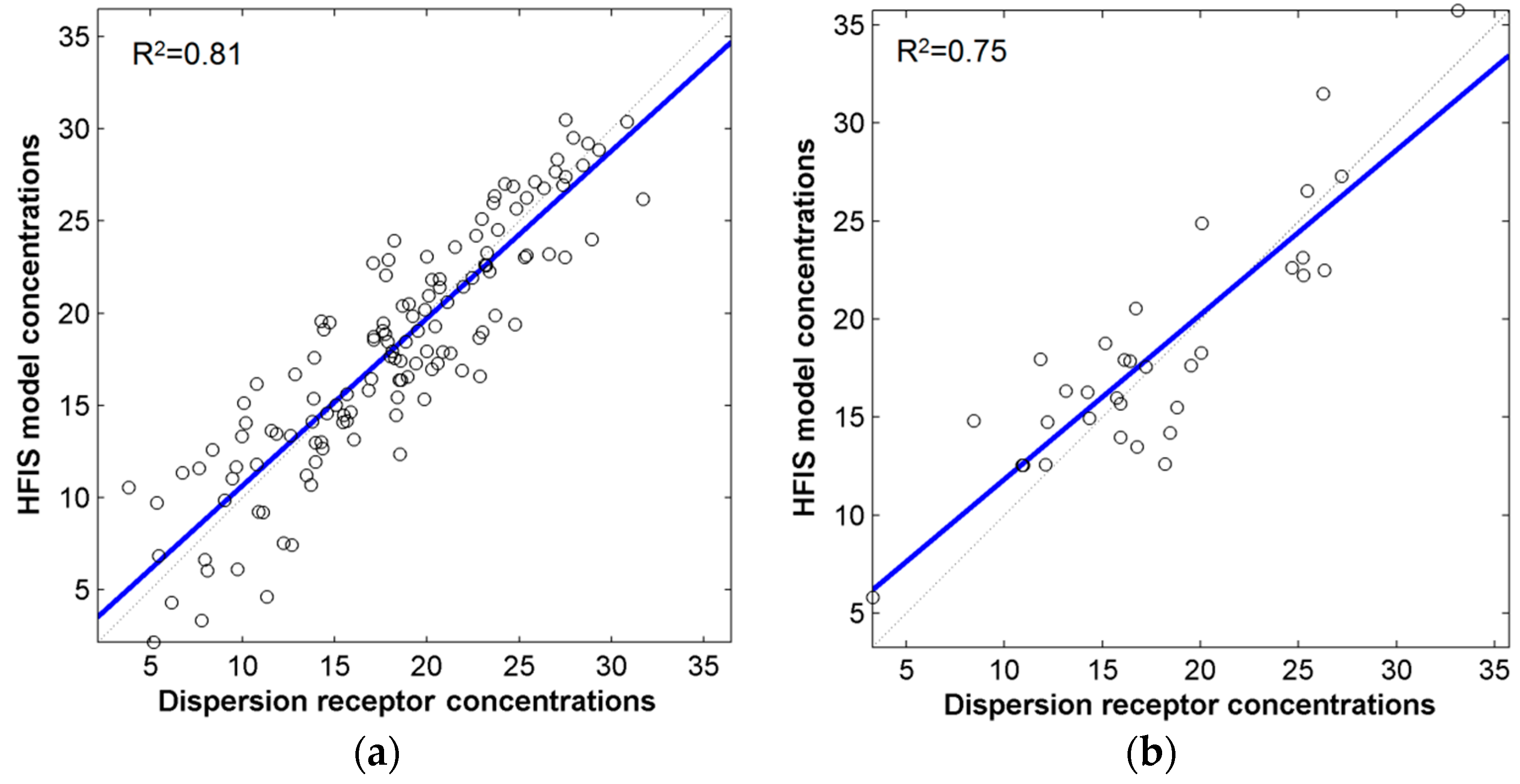
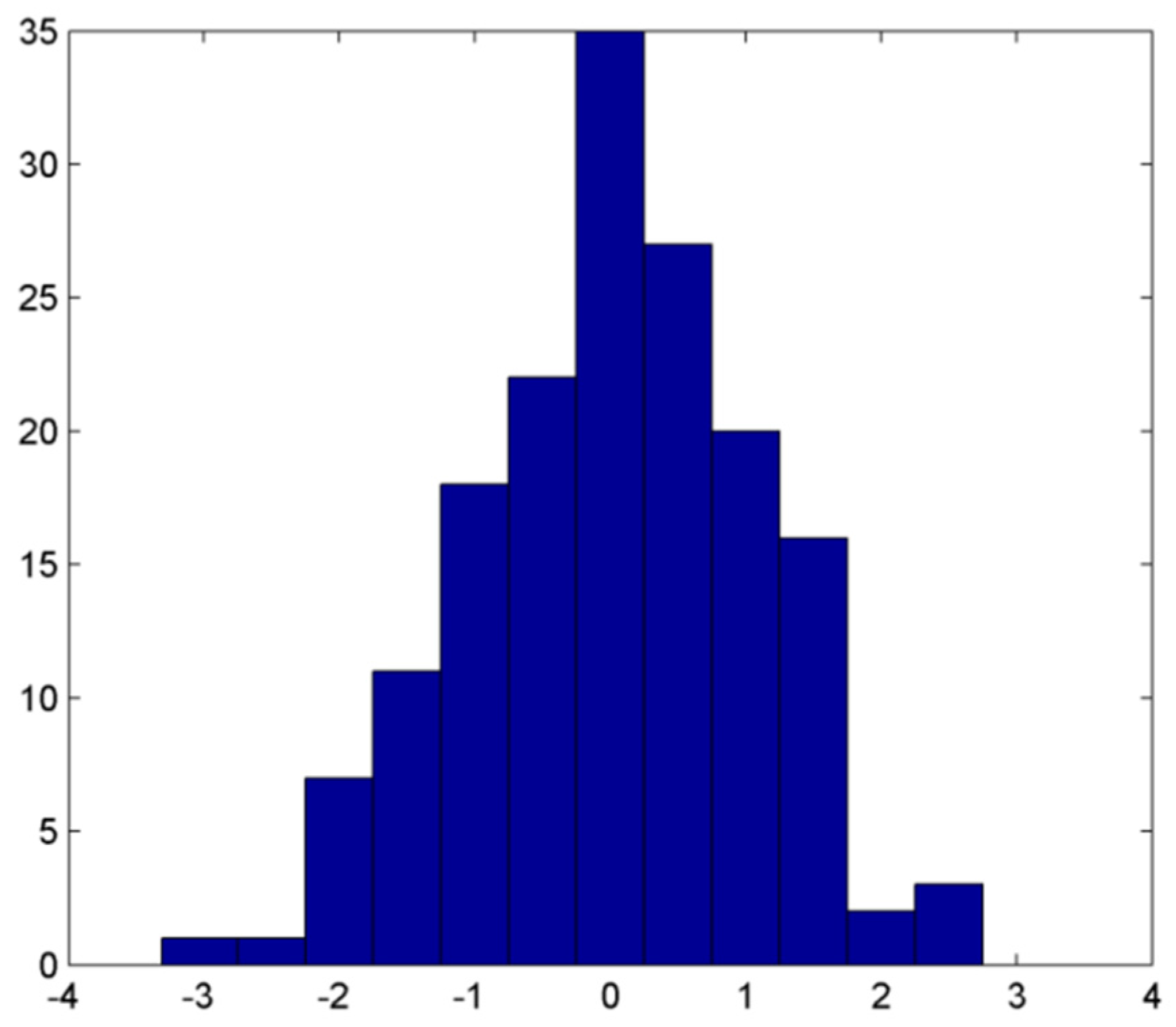

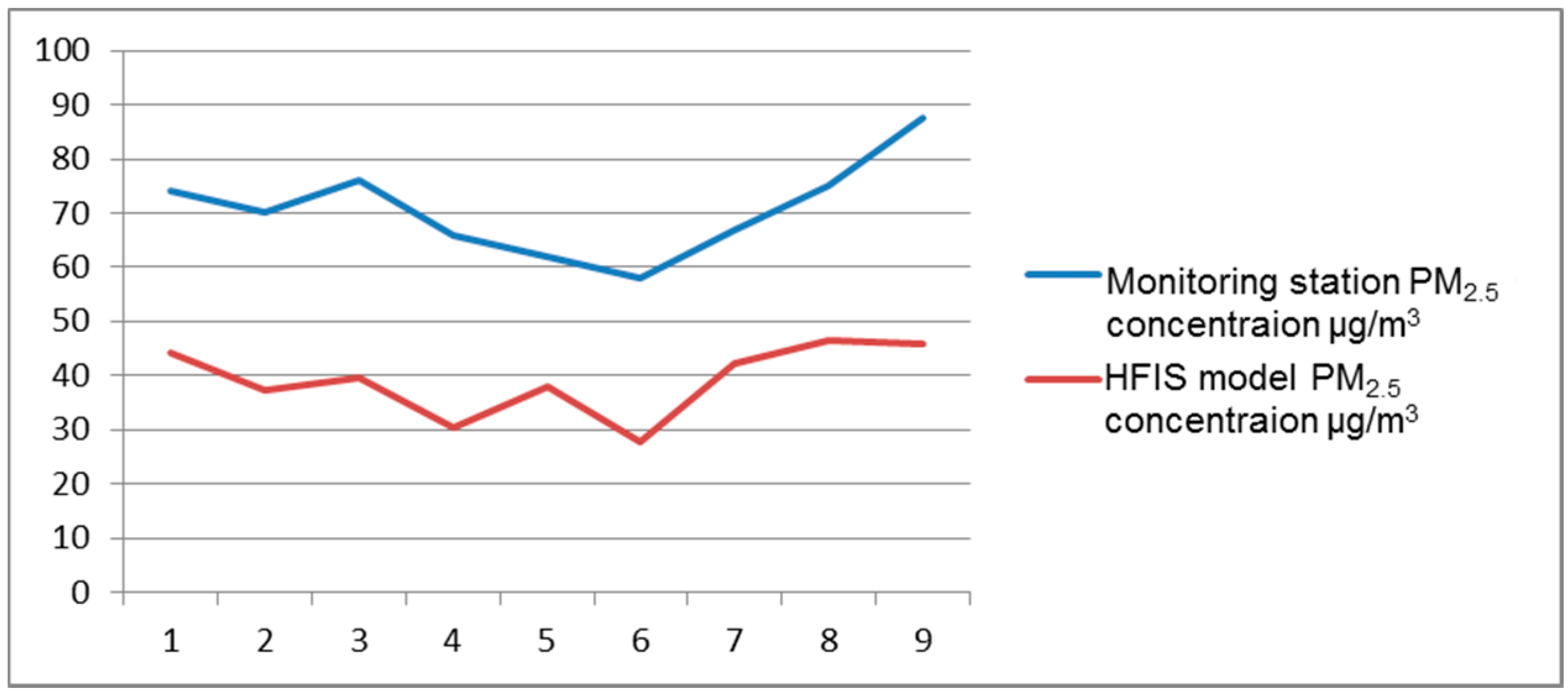
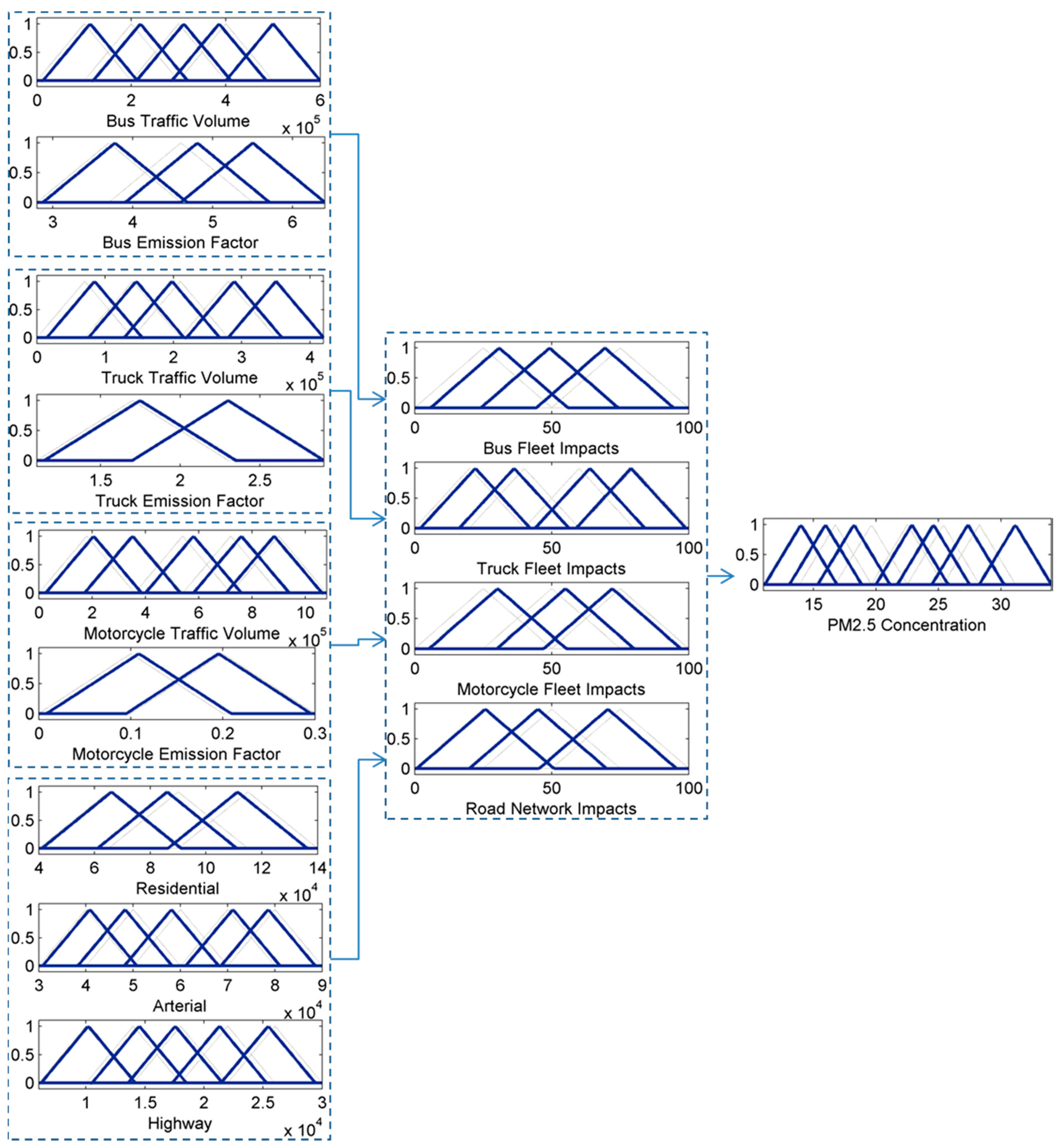

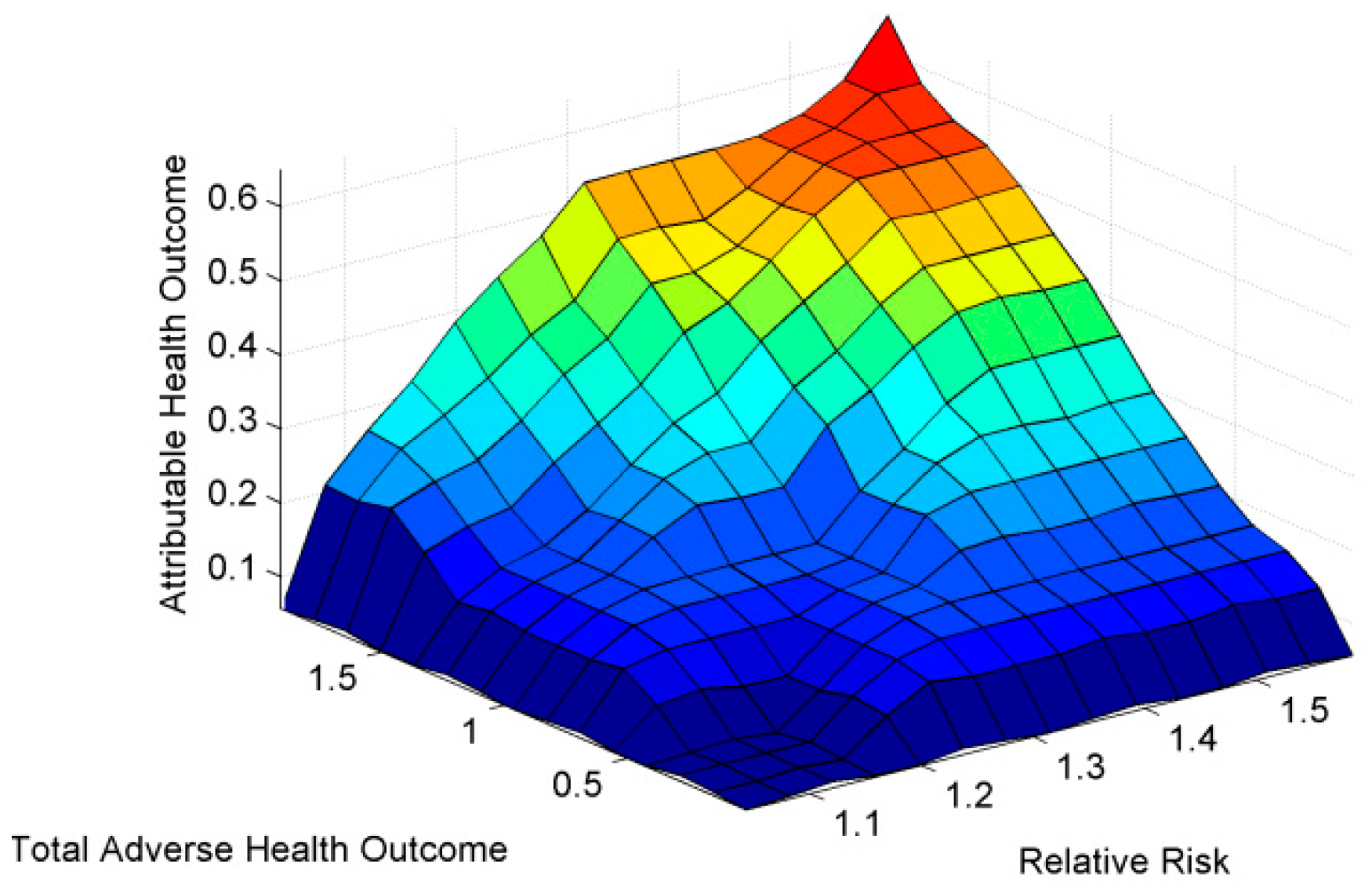
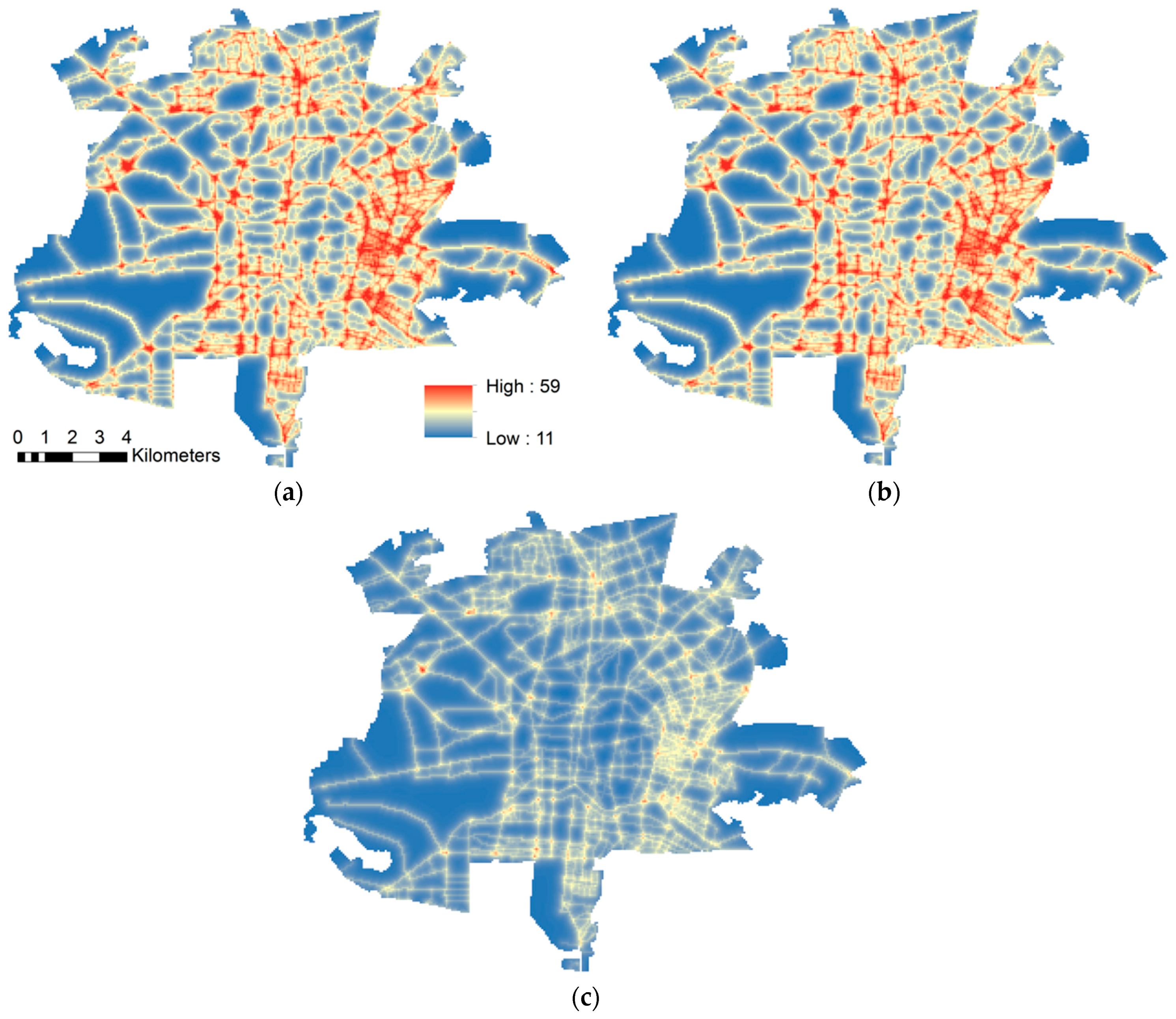
| Vehicle Types | Emission Standard | Percentage |
|---|---|---|
| Personal car | None | 7% |
| Euro 1 | 13% | |
| Euro 2 | 55% | |
| Euro 3 | 2% | |
| Euro 4 | 23% | |
| Bus | Euro 1 | 45% |
| Euro 2 | 29% | |
| Euro 3 | 25% | |
| Truck | Euro 1 | 39% |
| Euro 2 | 41% | |
| Euro 3 | 20% | |
| Motorcycle | None | 15% |
| Euro 2 | 85% |
| Emission Factor (gr/km) | Road Type | ||
|---|---|---|---|
| Residential | Arterial | Highway | |
| Passenger car | 0.1 | 0.1 | 0.1 |
| Bus | 6.4 | 4.9 | 2.8 |
| Truck | 2.9 | 2 | 1.1 |
| Motorcycle | 0.3 | 0.25 | 0.2 |
| Predictor Variables | Universe of Discourse |
|---|---|
| Passenger car traffic volume | [2 × 102–60 × 105] |
| Passenger car emission factor | [0–0.1] |
| Bus traffic volume | [0–6 × 105] |
| Bus emission factor | [2.8–6.4] |
| Truck traffic volume | [0–4.2 × 105] |
| Truck emission factor | [1.1–2.9] |
| Motorcycle traffic volume | [0–10.8 × 105] |
| Motorcycle emission factor | [0–0.3] |
| Residential | [4 × 104–14 × 104] |
| Arterial | [3 × 104–9 × 104] |
| Highway | [0.6 × 104–3 × 104] |
| Health Outcome | Disease Category | Baseline Incidence a | Dose Response Coefficient b |
|---|---|---|---|
| Mortality | Total | 543.5 | 0.00602 (0.00392–0.00797) |
| Cardiovascular | 231 | 0.01397 (0.00392–0.02390) | |
| Respiratory | 48.4 | 0.00295 (−0.00618–0.01222) |
| Model | RMSE for Training Dataset (RMSETra) | RMSE for Test Dataset (RMSETst) | Number of Rules (R) |
|---|---|---|---|
| HFIS for modeling PM2.5 (HFISPM) | 1.12 | 2.36 | 201.8 |
| HFIS for modeling total mortality (HFISTM) | 0.32 | 0.71 | 56.2 |
| HFIS for modeling cardiovascular mortality (HFISCM) | 0.29 | 0.67 | 54.8 |
| HFIS for modeling respiratory mortality (HFISRM) | 0.02 | 0.05 | 58.9 |
| Health Outcome | Disease Category | Scenario 1 | Scenario 2 | Scenario 3 |
|---|---|---|---|---|
| Mortality | Total | 1195 | 1215 | 756 |
| Cardiovascular | 1112 | 1129 | 724 | |
| Respiratory | 55 | 56 | 34 |
© 2017 by the authors; licensee MDPI, Basel, Switzerland. This article is an open access article distributed under the terms and conditions of the Creative Commons Attribution (CC-BY) license (http://creativecommons.org/licenses/by/4.0/).
Share and Cite
Tashayo, B.; Alimohammadi, A.; Sharif, M. A Hybrid Fuzzy Inference System Based on Dispersion Model for Quantitative Environmental Health Impact Assessment of Urban Transportation Planning. Sustainability 2017, 9, 134. https://doi.org/10.3390/su9010134
Tashayo B, Alimohammadi A, Sharif M. A Hybrid Fuzzy Inference System Based on Dispersion Model for Quantitative Environmental Health Impact Assessment of Urban Transportation Planning. Sustainability. 2017; 9(1):134. https://doi.org/10.3390/su9010134
Chicago/Turabian StyleTashayo, Behnam, Abbas Alimohammadi, and Mohammad Sharif. 2017. "A Hybrid Fuzzy Inference System Based on Dispersion Model for Quantitative Environmental Health Impact Assessment of Urban Transportation Planning" Sustainability 9, no. 1: 134. https://doi.org/10.3390/su9010134
APA StyleTashayo, B., Alimohammadi, A., & Sharif, M. (2017). A Hybrid Fuzzy Inference System Based on Dispersion Model for Quantitative Environmental Health Impact Assessment of Urban Transportation Planning. Sustainability, 9(1), 134. https://doi.org/10.3390/su9010134






